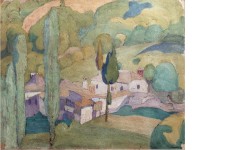TITΛΟΣ ΕΡΓΟΥΑΠΟΨΗ ΕΝΟΣ ΕΛΛΗΝΙΚΟΥ ΧΩΡΙΟΥ
ΔΙΑΣΤΑΣΕΙΣ ΕΡΓΟΥΎψος : 28
Πλάτος : 33.5
ΥΛΙΚΟ ΚΑΤΑΣΚΕΥΗΣΕλαιογραφία (Λάδι σε χαρτόνι)
ΥΠΟΓΡΑΦΗ ΚΑΛΛΙΤΕΧΝΗΚάτω Δεξιά
ΧΡΟΝΟΛΟΓΗΣΗ01-01-1924
ΕΛΕΓΧΟΣ ΓΝΗΣΙΟΤΗΤΑΣΔεν έχει ελεγχθεί

Footnotes
Bearing certificate of authenticity from the artists daughter Mina Papalouka (on the reverse)
Painted in 1924.
One of the most distinctive works by a true master of 20th century Greek art, executed in 1924 according to the date noted on the back by Mina Papalouka, the artists daughter. It belongs to an exquisite group of paintings that established Spyros Papaloukas as a leading exponent of Greek landscape painting.
In early November 1923, the artist went to Mt. Athos where he stayed for an entire year studying natures untameable green.1 Indeed, in this painting it is evident that the artist is trying to tame the sea of green and capture the mystery of the man made environment that seems to be trying to spring forth from the landscape. As Prof. A. Prokopiou notes in his Mt. Athos paintings, Papaloukas introduces the iconography of the rural abode that would be imitated later by most Greek landscape painters.2 As if he were making a Byzantine mosaic, he ignores western perspective and endeavours to liberate colour from its obligation to describe reality. This perception is also of pivotal importance to the art of the Nabis, Cezanne and the cubist experiments at the beginning of the 20th century.
M. Lambraki-Plaka, the director of the National Gallery in Athens, notes: the Mt. Athos landscape posed new problems for Papaloulas: the infinite variations of green, the filtered light, so different from the dry light of Aegina, the complex architecture of the monasteries with their often unexpected variety of colours. But Papaloukas loved this challenge. Speaking on the landscape he once said: Within the landscape one finds the valuable qualities of colour, tonality and design3
In View of a Greek village soft and cool tonalities, without intense gradations, dominate bathed in diffused light. One almost believes that the buildings are loosing their structural integrity and material substance. The vertical, slender cypresses, typical of the Mt. Athos landscape, emerge triumphantly from a field of pink, turquoise and violet hues, as if wanting to break out from the paintings narrow confines and reach the sky, timeless symbols of eternity.4 The feeling that the subject has escaped from the boundaries of the canvas, presenting the image as a fragment of broader reality, tends towards the creation of a nearly abstract sum total of shapes. The landscape no longer represents a specific place but reflects the infinite from whence ideal forms originate. Papaloukas expertly trained eye reveals the eternal becoming of the world. As he once said up there, in Mt. Athos I clearly saw that art in all its great manifestations through the ages has always been about form and colour.5
1. S. Doukas, Spyros Papaloukas, Zygos magazine no.31, May-June 1958, p. 7
2. A. Prokopiou, History of Art 1750-1950, vol.2 [in Greek], Athens, 1968, p. 497
3. M. Lambraki-Plaka, Papaloukas Painting in Spyros Papaloukas, Painting 1892-1957 [in Greek], ed. Ionian Bank, Athens 1995, p.37
4. See A. Kouria, Spyros Papaloukas Athos, and G. Gavalaris, Spyros Papaloukas: Longing for Infinity in Spyros Papaloukas /Apprenticing in Mt. Athos [in Greek], Athos 2003, pp. 19-30
5. Doukas, p. 8